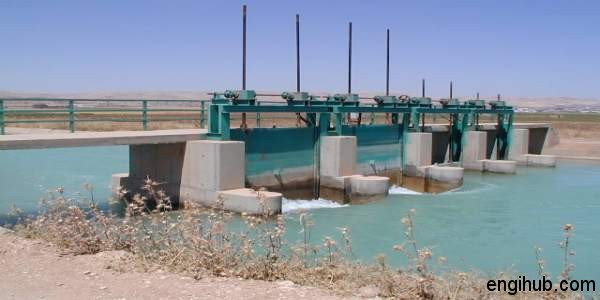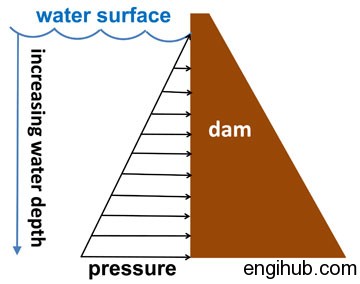Hence the study of Hydrostatics is more important in engineering.
In this post, I will cover practical applications of Hydrostatics on the following Structures.

So, here are the 3 practical applications of Hydrostatics you must know
Water Pressure on Sluice Gate by Hydrostatics
To regulate the flow of water, in the path of a River, a Sluice Gate is provided.
Hence the Sluice Gate is made to move up and down with the help of Rollers fixed on Skin Plate, which travels on Vertical Rails called Guide.
These Rails are fixed on Piers or Vertical Walls.
In between these two Skin Plates, a number of I-beams are provided horizontally to withstand the Water Pressure.
The spacing between the I-beam is lesser at the bottom than that at top of the Sluice Gate, as the Water Pressure varies in depth.
Water Pressure on Masonry Walls
When Water is on one side of the Masonry Walls, the Pressure will act perpendicular to the Wall.
A little consideration will show, that the intensity of Pressure at the Water Level will be Zero and will be increased by a Straight Line Law to wH at the bottom.
Thus the Pressure of the Water on a Vertical Wall will act through a point at a distance H/3 from the bottom, where H is the depth of Water.
Conditions for Stability of Dam by Hydrostatics
01) The Resultant must pass within the base to safeguard the Dam against Overturning.
02) The Resultant must pass through the middle third of the base, to avoid tension at the base.
03) To prevent sliding, the maximum Frictional Force should be more than the Horizontal Force.
04) The Maximum Stress developed at the bottom of the Dam should be within the permissible Stress of the site.

Water Pressure on Lock Gate by Hydrostatics
The Water Level on both sides of the Dam will be different.
If it is desired to have Boating in such a river, the Chamber, known as Lock, is constructed between these two different Water Levels.
Two sets of Lock Gates are provided in order to transfer a Boat from Higher Water Level to Lower Water Level.
The Upstream gates are opened, and the Water Level in the Chamber is risen up to the Upstream Water level.
The Boat is then shifted in the chamber, then Upstream Gates are closed Downstream Gates are opened and the Water Level in the Chamber is lowered to the Downstream Water level.
The procedure is reversed for the transfer of the Boat from Downstream to Upstream.
Besides this information, you are suggested to read something more from below engineering books
To get the more details about the topic, I further recommended reading
- A Textbook of Hydraulic Machines
- A Textbook of Hydraulics, Fluid Mechanics, and Hydraulic Mechanics
- Textbook of Fluid Mechanics and Hydraulic Machines
- A Textbook of Fluid Mechanics and Hydraulic Machines
If you like the post, share it with your friends and also on social sites.



